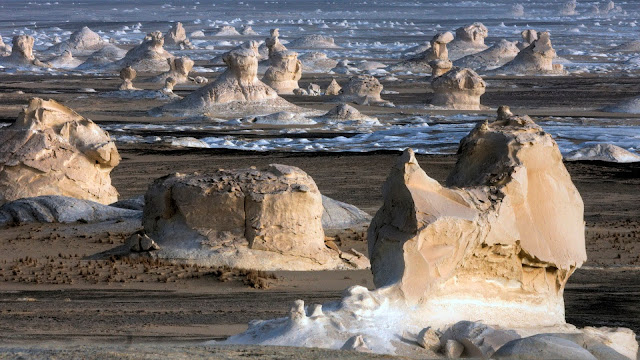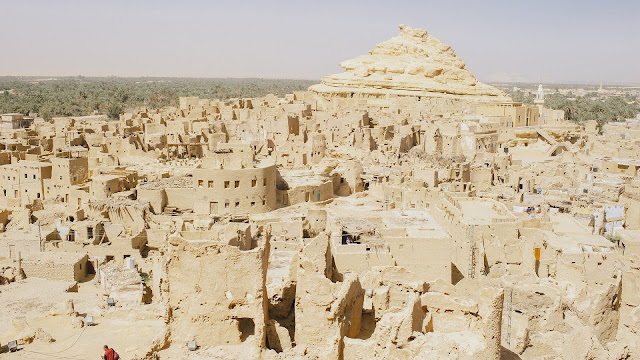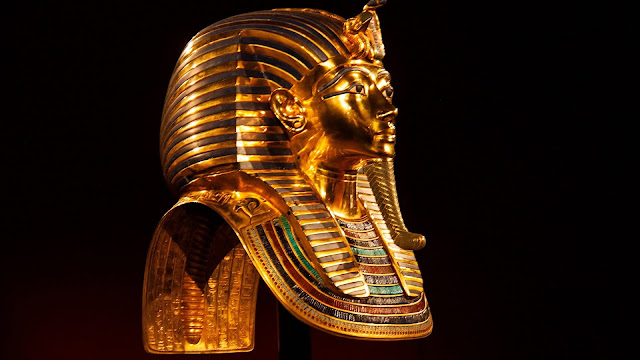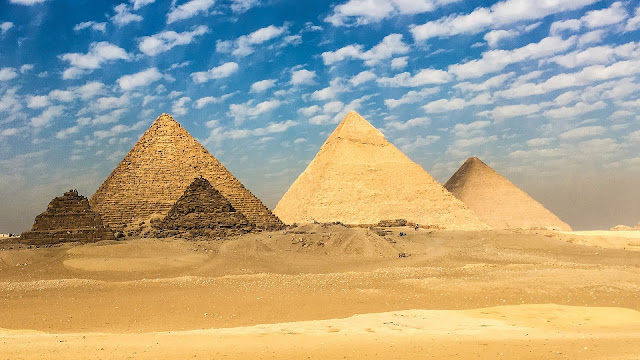Egypt is in north-eastern Africa with its capital located in its largest city, Cairo. Famous for its ancient civilization and some of the world’s most famous monuments in the Nile Valley, including the Giza pyramids, the Great Sphinx and the ancient temples of Luxor dating back thousands of years: (Abu Simbel temples, Karnak Temple Complex and Valley of the Kings). In addition, the country is bounded by the Mediterranean and Red Seas, is one of the most beautiful places in the world to go diving. For desert fans and adventurers, the white desert is a place not to be missed, is one of the most astounding natural wonders of Egypt.
10. White Desert
The white desert is one of the most astounding natural wonders of Egypt. The strange rock formations that rise above the white surface of the desert are known as inselbergs. At Farafra, they form a 20km long series of free-standing formations in front of the northern escarpment. They are formed when a plateau begins to break down leaving the harder rock still standing while the softer parts erode. The rock layers were deposited when the desert was underwater and marine fauna which died settled at the bottom of the ocean forming sedimentary rocks. Almost as soon as you enter the White Desert you are surrounded by gleaming white mushroom shapes. For desert fans and adventurers, this is a place not to be missed.
9. Mosque of Ibn Tulun
The Mosque of Ibn Tulun is located in Cairo, Egypt. Built between 876 and 879 AD, is one of the oldest mosque in the city surviving in its original form. It was commissioned by Ahmad ibn Ţūlūn, the Turkic Abbassid governor of Egypt. The mosque is constructed around a courtyard, with one covered hall on each of the four sides, the largest being on the side of the qibla, or direction to Mecca. The original mosque had its ablution fountain (sabil) in the area between the inner and outer walls. A distinctive sabil with a high drum dome was added in the central courtyard at the end of the thirteenth century by the Sultan Lajīn.[
wiki]
8. Siwa Oasis
The Siwa Oasis is an oasis in Egypt, located in the Libyan Desert. Siwa is one of Egypt's most isolated settlements, with 23,000 people, mostly Berbers who developed a unique culture and a distinct language of the Berber family called Siwi. Its fame lies primarily in its ancient role as the home to an oracle of Amon, the ruins of which are a popular tourist attraction which gave the oasis its ancient name Ammonium. Siwa was an oasis vital to the trade route, as the natural springs and shade giving palm trees gave travelers respite from the desert.
7. Egyptian Museum
The Egyptian Museum is home to an extensive collection of ancient Egyptian antiquities in Cairo. The original collection was established in the late 19th century under Auguste Mariette and housed in Boulaq. Designed in the Neoclassical style by Marcel Dourgnon, the Egyptian Museum boasts 107 halls filled with artifacts dating from the prehistoric through the Roman periods, with the majority of the collection focused on the pharaonic era. The museum houses approximately 120,000 objects covering 5,000 years of Egypt's past. Highlights include the objects from the Tomb of Tutankhamen and the Royal Mummy Room containing 27 royal mummies from pharaonic times. It is one of Cairo’s top attraction.
6. River Nile Cruise
The Nile is a major north-flowing river in northeastern Africa, generally regarded as the longest river in the world. It is a popular tourist destination for cruising. Almost all Egyptian cruise ships travel the Luxor-Aswan route which is safe, scenic and terminates at two of Egypt’s most important towns. With so many things to see, a Nile River cruise includes plenty of tours, but there's also time to relax and watch the world float by.
5. Abu Simbel
The Abu Simbel temples are two massive rock temples at Abu Simbel, a village in Nubia, southern Egypt, near the border with Sudan. The twin temples were originally carved out of the mountainside during the reign of Pharaoh Ramesses II in the 13th century BC, as a lasting monument to himself and his queen Nefertari, to commemorate his victory at the Battle of Kadesh. The complex was relocated in its entirety in the 1960s, on an artificial hill made from a domed structure, when the temples were threatened by submersion in Lake Nasser.
4. Valley of the Kings (Tomb of King Tutankhamen)
The Valley of the Kings is an Egyptian archaeological locality in the hills immediately behind the West Bank of Luxor. For a period of nearly 500 years from the 16th to 11th century BC, tombs were constructed for the Pharaohs and powerful nobles of the New Kingdom. The valley is known to contain 63 tombs and with over 120 chambers. It was the principal burial place of the major royal figures of the Egyptian New Kingdom, as well as a number of privileged nobles. The royal tombs are decorated with scenes from Egyptian mythology and give clues to the beliefs and funerary rituals of the period. Almost all of the tombs seem to have been opened and robbed in antiquity except for the famous tomb of Tutankhamun. It is one of the most famous archaeological sites in the world.
3. Red Sea Reef
The Red Sea is a seawater inlet of the Indian Ocean, lying between Africa and Asia. The waters of the Red Sea are renowned for their spectacular visibility and features some of the most exotic seascapes. With its wide expanse of coral formation on the reefs, it is home to thousands of different sea creatures: is the habitat of over 1,000 invertebrate species, and 200 soft and hard corals. The Red Sea is one of the most beautiful places in the world to go diving.
2. Karnak
The Karnak Temple Complex, commonly known as Karnak, comprises a vast mix of decayed temples, chapels, pylons, and other buildings. The Temple of Karnak actually consists of three main temples, smaller enclosed temples, and several outer temples located about 2.5 kilometers north of Luxor. One of most famous structures of Karnak is the Hypostyle Hall, a hall area of 5,000 m2 (50,000 sq ft) with 134 massive columns arranged in 16 rows. Karnak was a high-precision ancient observatory according to Norman Lockyer.
1. Giza Necropolis (Pyramids of Giza)
The Giza pyramid complex is an archaeological site on the Giza Plateau, on the outskirts of Cairo, Egypt. It includes the three pyramid complexes known as the Great Pyramids, the massive sculpture known as the Great Sphinx, several cemeteries, a workers' village and an industrial complex. One of the premier attractions of Egypt, the Pyramids of Giza represent the archetypal pyramid structures of ancient Egyptian civilisation and - together with the Sphinx at the base of the Giza plateau - are the iconic image of Egypt.










 Reviewed by Bynn Du
on
5/05/2017
Rating:
Reviewed by Bynn Du
on
5/05/2017
Rating:
 Reviewed by Bynn Du
on
5/05/2017
Rating:
Reviewed by Bynn Du
on
5/05/2017
Rating:










Không có nhận xét nào: